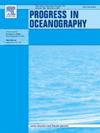Tropical cyclones enhance net CO2 sink in the Bay of Bengal
IF 3.6
3区 地球科学
Q1 OCEANOGRAPHY
引用次数: 0
Abstract
Tropical cyclones modify the upper ocean due to significant mixing associated with increased winds that bring CO2 and nutrient-rich subsurface waters to the surface, altering CO2 flux and biological production. In the region where considerable river discharge occurs with strong stratification, it is hypothesized that tropical cyclones may increase the sink of CO2 into the ocean and vice versa in the region of weak stratification. The balance between CO2 removal through the exchange at the air–water interface and biological production on a shorter time scale may vary with the intensity of the cyclone. To examine this, severe cyclone Michaung and very severe cyclone Hudhud was studied to understand the modifications in CO2 fluxes and net primary production (NPP) in the Bay of Bengal. Both these cyclones occurred in the Bay of Bengal during post monsoon season (October to December) and crossed the land on the east coast of India. The barrier layer thickness was > 40 m in the northern and < 10 m in the southern Bay, resulting in spatial variability in the mixing of the upper ocean. High windspeed associated with cyclones may not rupture the stratification in the northern Bay. This led to an increase in a sink of CO2 from the atmosphere in the northern Bay, whereas the sink was decreased in the southern Bay due to an increase in pCO2 levels through mixing with subsurface waters. In the case of severe cyclone Michaung, the decrease in flux of CO2 due to an increase in pCO2 levels in the surface water through mixing was compensated by an increase in CO2 removal through NPP. In contrast, the decrease in CO2 sink due to the very severe cyclone Hudhud was lower than the increase in NPP, resulting in a net sink of CO2 in the Bay of Bengal. This study suggests that tropical cyclones may enhance CO2 sink into the Bay of Bengal. An increase in the number and intensity of tropical cyclones is projected in future due to climate change that may help to achieve net zero emissions in future.
热带气旋增强了孟加拉湾的二氧化碳净汇
热带气旋改变了上层海洋,因为与增加的风相关的显著混合将二氧化碳和富含营养的地下水带到地表,改变了二氧化碳通量和生物生产。在强分层区出现大量河流流量的区域,假设热带气旋可能增加进入海洋的CO2汇,而在弱分层区则相反。在较短的时间尺度上,通过空气-水界面交换去除CO2和生物生产之间的平衡可能随着气旋的强度而变化。为了验证这一点,研究了强气旋Michaung和极强气旋Hudhud,以了解孟加拉湾二氧化碳通量和净初级生产量(NPP)的变化。这两个气旋都在季风季节后(10月至12月)发生在孟加拉湾,并穿过印度东海岸的陆地。阻挡层厚度为>;北部和东部40米;在南海湾10米,导致上层海洋混合的空间变异性。与气旋有关的高风速可能不会破坏北湾的分层。这导致北湾大气中的二氧化碳汇增加,而南湾的二氧化碳汇减少,这是由于二氧化碳分压水平通过与地下水混合而增加。在强气旋micung的情况下,由于混合导致地表水中二氧化碳分压水平增加而导致的二氧化碳通量减少被通过NPP增加的二氧化碳去除量所补偿。相比之下,由于非常严重的气旋Hudhud造成的CO2汇的减少低于NPP的增加,导致孟加拉湾的CO2净汇。这项研究表明,热带气旋可能会增加进入孟加拉湾的二氧化碳沉降。由于气候变化,预计未来热带气旋的数量和强度将有所增加,这可能有助于在未来实现净零排放。
本文章由计算机程序翻译,如有差异,请以英文原文为准。
求助全文
约1分钟内获得全文
求助全文
来源期刊

Progress in Oceanography
地学-海洋学
CiteScore
7.20
自引率
4.90%
发文量
138
审稿时长
3 months
期刊介绍:
Progress in Oceanography publishes the longer, more comprehensive papers that most oceanographers feel are necessary, on occasion, to do justice to their work. Contributions are generally either a review of an aspect of oceanography or a treatise on an expanding oceanographic subject. The articles cover the entire spectrum of disciplines within the science of oceanography. Occasionally volumes are devoted to collections of papers and conference proceedings of exceptional interest. Essential reading for all oceanographers.
 求助内容:
求助内容: 应助结果提醒方式:
应助结果提醒方式:


